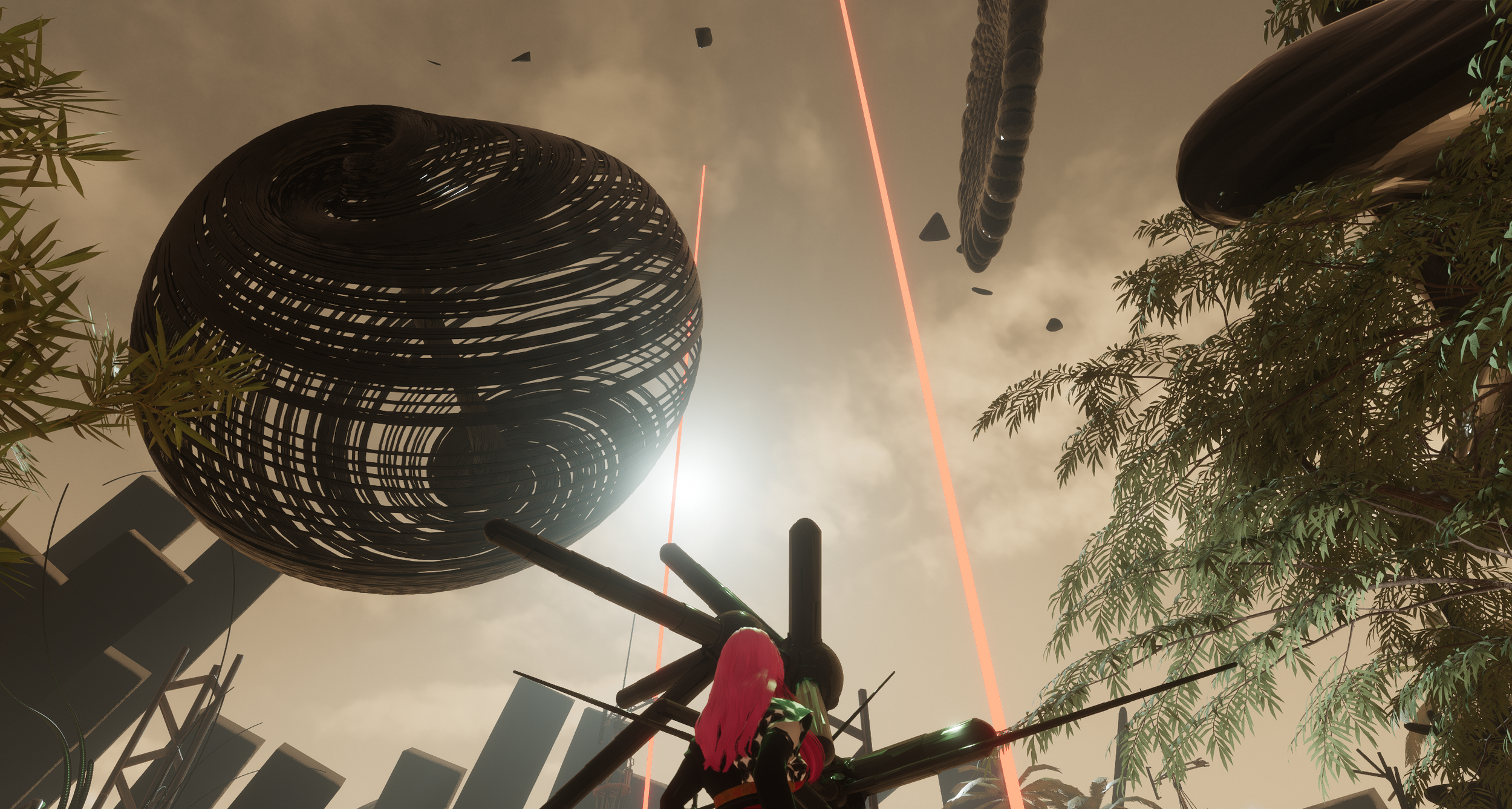Sphere5
Sphere5 (AvantGarden)
Virtual reality art installation published on Sansar, 2021.
3D graphics, world building, digital sculptures, sound: Tanja Vujinovic
Additional assets for the world and avatar: Sansar Store
Production: Tanja Vujinović / Ultramono, 2021.
Consulting.
Arijana Filipić, Department of Biotechnology and Systems Biology, National Institute of Biology
Prof. George Poinar, College of Science at Oregon State University
Dr Jelena Guga, researcher
Dr Vid Podpečan, Department of Knowledge Technologies, Jožef Stefan Institute
Ivan Stanić, curator and artist
Friends from Sansar
AvantGarden Sphere5 by Tanja Vujinovic belongs to her series of artworks for social VR spaces. Sphere5 is inspired by Arcadian gardens in a broad philosophical sense. If it wasn’t for the sand as the base of this world, we could easily think in terms of the perfect heterotopias, as they were envisioned by Michel Foucault, like gardens detached from ordinary life. Contemporary living in urban areas is progressively disabling access to natural spaces and, therefore, being in nature becomes the lingering dream of a constantly fleeting, unattainable object of desire.
Sphere5 is inhabited by biomimetic machines, Dyson spheres, and stone flowers that appeared from the roots of carboniferous plants. Within this garden, we get into the relationships with non-human agents, emerging from the cloud of mythology. AvantGarden would not be a meta-garden without proto-machines, devices of the future arising from speculative ideas about renewable energy resources, clean industrial development of goods, and hopeful dreams of a world without pollution. Although a multitude of alternative ecological solutions is being developed nowadays, we are yet to see if any of them will be used on a wider scale. Until then, we might think along the lines of these semi-imaginary, intelligent, self-operating, and self-assembling machines that are working synergistically with their surroundings.
Sphere5 is published on Sansar, an amalgam of a computer game and a social platform, and it is a virtual club garden that enables us to explore virtual reality as a social space of connectedness, featuring a minimal techno audio-visual set or special events scheduled by the author.
Sphere5 project REFERENCES
Filipić, Arijana, Gregor Primc, Rok Zaplotnik, Nataša Mehle, Ion Gutierrez-Aguirre, Maja Ravnikar, Miran Mozetič, Jana Žel, and David Dobnik. 2019. “Cold Atmospheric Plasma as a Novel Method for Inactivation of Potato Virus Y in Water Samples.” Food and Environmental Virology, April. https://doi.org/10.1007/s12560-019-09388-y
Carboniferous. Wikipedia, https://en.wikipedia.org/wiki/Carboniferous. Accessed 31 Jan. 2019.
Stoneman, Lisa, and Dorothy Belle Poli. Drawing New Boundaries: Finding the Origins of Dragons in Carboniferous Plant Fossils. Leonardo, Nov. 2017.
Foucault, Michel. “Of Other Spaces.” Diacritics, Johns Hopkins University Press, 1986.
Pogue Harrison, Robert. Gardens, An Essay on the Human Condition. The University of Chicago Press, 2008.
Ponting, Klajv. Ekološka Istorija Sveta Životna Sredina i Propast Velikih Civilizacija. Odiseja, 2009.
Benyus, Janine M. Biomimicry Innovation Inspired by Nature. HarperCollins, 1997.
Pogue Harrison, Robert. Gardens, An Essay on the Human Condition. The University of Chicago Press, 2008.
BBC Click. Can Technology Help You Live Longer? - BBC Click. YouTube, https://www.youtube.com/watch?v=8HwOrFzHePA. Accessed 16 Aug. 2018.
Inaji, Tashiro. The Garden as Architecture: Form and Spirit in the Gardens of Japan, China, and Korea. KODANSHA INTERNATIONAL, 1998.
Bey, Hakim. T.A.Z: The Temporary Autonomous Zone, Ontological Anarchy, Poetic Terrorism. 2nd rev. ed. New York: Autonomedia, 2003.
Flusser, Vilém. Towards a Philosophy of Photography. London: Reaktion Books, 2000.
Guattari, Félix. Chaosmosis: An Ethico-Aesthetic Paradigm. Bloomington: Indiana University Press, 1995.
Leslie, Esther. Synthetic Worlds Nature, Art and the Chemical Industry. Reaktion Books, 2005.
Nachmanovitch, Stephen. Free Play: Improvisation in Life and Art (version Reprint). Reprint. Tarcher, 1991.
Oliveira, A. J. “Europe’s New Mars Yard Is Like a Playground for Planetary Engineers.” Atlas Obscura, 26:00 400AD. http://www.atlasobscura.com/articles/esa-mars-yard.
Reynolds, Simon. Energy Flash: A Journey through Rave Music and Dance Culture. Berkeley, Calif.: Soft Skull, 2012.
William Williamson. The Question of Love, 2020. https://www.youtube.com/watch?v=CytC6A-K8c4
Dockrill, Peter. “Scientists Identify New Flower From a Forest That Existed 100 Million Years Ago.” ScienceAlert. Accessed December 26, 2020. https://www.sciencealert.com/scientists-identify-new-flower-from-a-forest-that-existed-100-million-years-ago.
Sauquet, Hervé, Maria von Balthazar, and Jürg Schönenberger. “The Ancestral Flower of Angiosperms and Its Early Diversification.” Nature Communications, 2017.
Hrala, Josh. “This Flower Has Been Perfectly Preserved in Amber For 15 Million Years.” ScienceAlert. Accessed January 15, 2021. https://www.sciencealert.com/this-poisonous-flower-has-been-trapped-in-amber-for-15-million-years.
“Chinese Garden.” Wikipedia, 20 June 2018. Wikipedia, https://en.wikipedia.org/w/index.php?title=Chinese_garden&oldid=846716563.
“Lingzhi Mushroom.” Wikipedia, 9 Aug. 2018. Wikipedia, https://en.wikipedia.org/w/index.php?title=Lingzhi_mushroom&oldid=854219928.
“Transhumanism.” Wikipedia, 14 Aug. 2018. Wikipedia, https://en.wikipedia.org/w/index.php?title=Transhumanism&oldid=854849226.
“Non-Game.” In Wikipedia, February 1, 2020. https://en.wikipedia.org/w/index.php?title=Non-game&oldid=938583267.
“Terrestrial Analogue Sites.” Wikipedia, September 20, 2020. https://en.wikipedia.org/w/index.php?title=Terrestrial_analogue_sites&oldid=979459958.
“Shinto.” In Wikipedia, October 9, 2020. https://en.wikipedia.org/w/index.php?title=Shinto&oldid=982611897.
“Dyson Sphere.” In Wikipedia, December 27, 2020. https://en.wikipedia.org/w/index.php?title=Dyson_sphere&oldid=996511440.
‘Ganoderma Lucidum’. In Wikipedia, 29 June 2021. https://en.wikipedia.org/w/index.php?title=Ganoderma_lucidum&oldid=1031024905.
‘Arcadia (Utopia)’. In Wikipedia, 12 July 2021. https://en.wikipedia.org/w/index.php?title=Arcadia_(utopia)&oldid=1033310273.
‘Utopia’. In Wikipedia, 30 July 2021. https://en.wikipedia.org/w/index.php?title=Utopia&oldid=1036255985.
Zizek On Utopia. Accessed 2 August 2021.https://vimeo.com/7527571.









































